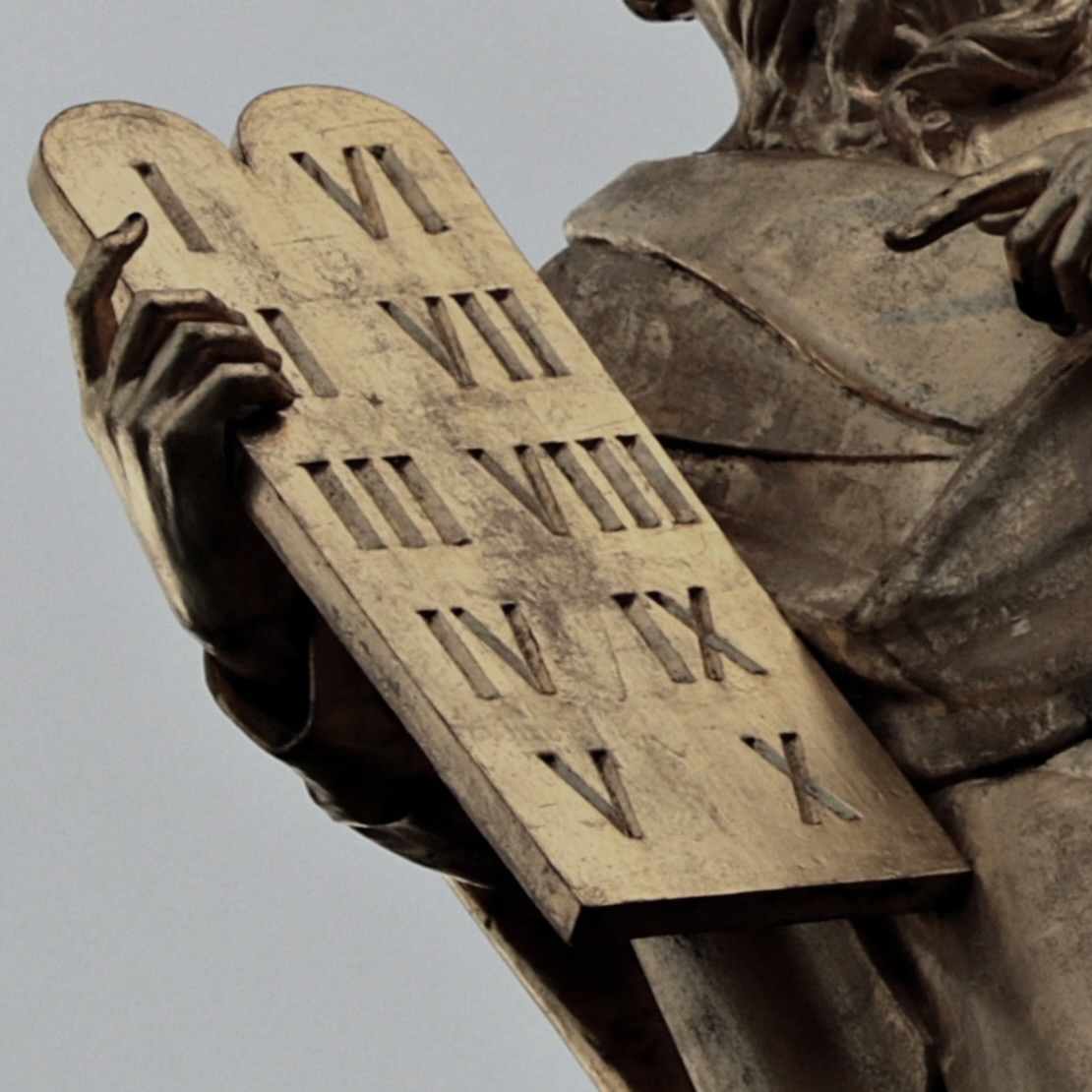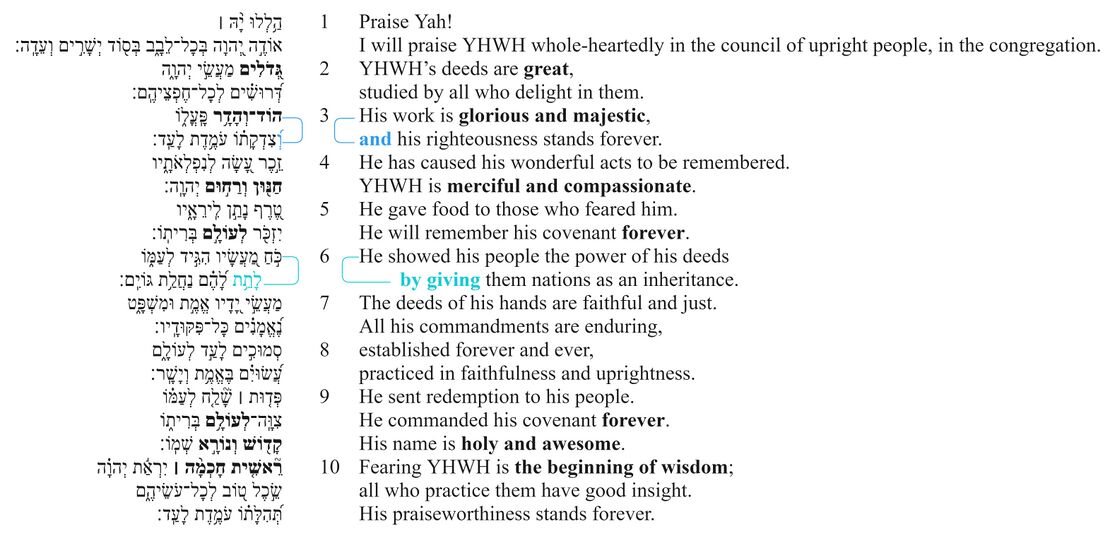Psalm 111 Macrosyntax
From Psalms: Layer by Layer
Psalm 111/Macrosyntax
Choose a PsalmNavigate Psalm 111
Macrosyntax
Macrosyntax Diagram
| Macrosyntax legend | |
|---|---|
| Vocatives | Vocatives are indicated by purple text. |
| Discourse marker | Discourse markers (such as כִּי, הִנֵּה, לָכֵן) are indicated by orange text. |
| The scope governed by the discourse marker is indicated by a dashed orange bracket connecting the discourse marker to its scope. | |
| The preceding discourse grounding the discourse marker is indicated by a solid orange bracket encompassing the relevant clauses. | |
| Subordinating conjunction | The subordinating conjunction is indicated by teal text. |
| Subordination is indicated by a solid teal bracket connecting the subordinating conjunction with the clause to which it is subordinate. | |
| Coordinating conjunction | The coordinating conjunction is indicated by blue text. |
| Coordination is indicated by a solid blue line connecting the coordinating clauses. | |
| Coordination without an explicit conjunction is indicated by a dashed blue line connecting the coordinated clauses. | |
| Marked topic is indicated by a black dashed rounded rectangle around the marked words. | |
| The scope of the activated topic is indicated by a black dashed bracket encompassing the relevant clauses. | |
| Marked focus or thetic sentence | Marked focus (if one constituent) or thetic sentences[1] are indicated by bold text. |
| Frame setters[2] are indicated by a solid gray rounded rectangle around the marked words. | |
| [blank line] | Discourse discontinuity is indicated by a blank line. |
| [indentation] | Syntactic subordination is indicated by indentation. |
| Direct speech is indicated by a solid black rectangle surrounding all relevant clauses. | |
| (text to elucidate the meaning of the macrosyntactic structures) | Within the CBC, any text elucidating the meaning of macrosyntax is indicated in gray text inside parentheses. |
If an emendation or revocalization is preferred, that emendation or revocalization will be marked in the Hebrew text of all the visuals.
| Emendations/Revocalizations legend | |
|---|---|
| *Emended text* | Emended text, text in which the consonants differ from the consonants of the Masoretic text, is indicated by blue asterisks on either side of the emendation. |
| *Revocalized text* | Revocalized text, text in which only the vowels differ from the vowels of the Masoretic text, is indicated by purple asterisks on either side of the revocalization. |
(Click diagram to enlarge)
There are no notes on divisions for this psalm.
- v. 2a. The fronting of גְּדֹלִים is poetic (ג line of acrostic) and probably also information-structural. Although "YHWH's deeds" have not been mentioned until this point, they are implied by אודה יהוה in the previous verse—the word אודה means "action by which humans openly express recognition of what someone else has done or achieved" (SDBH, italics added). The fronted predicate thus "establishes... [the] state or features... of the discourse active subject of a verbless clause" (BHRG 47.3.2).
- v. 3a. The fronting of הוֹד־וְהָדָר is, like גְּדֹלִים, both poetic (ה line of acrostic) and information-structural (cf. BHRG 47.3.2).
- v. 4a. The fronting of the object זֵכֶר is probably poetic, fitting the acrostic structure (ז line). The placement of לְנִפְלְאֹתָיו at the end of the line, even though it modifies the זֵכֶר, might be due to the length of לְנִפְלְאֹתָיו.
- v. 4b. The fronting of חַנּוּן וְרַחוּם is poetic, and, like the other verbless clauses in the psalm (vv. 2a, 3a, 9c, 10a), probably also information–structural (cf. BHRG 47.3.2).
- v. 5a. The fronting of the object טֶרֶף is poetic, fitting the acrostic structure (ט line).
- v. 5b. The adverbial לְעוֹלָם is placed before the object, probably to stress YHWH's ongoing commitment to his covenant: YHWH's covenant faithfulness is not just a matter of the past (cf. v. 5a). Rather, he will remember his covenant forever.
- v. 6a. The fronting of כֹּחַ מַעֲשָׂיו is probably poetic, fitting the acrostic structure (כ line).
- v. 7b. The fronting of the predicate נֶאֱמָנִים is poetic, both fitting the acrostic (נ line) and forming a chiasm in v. 7: S SC [אמת] // SC [אמן] S]).
- v. 9a. The fronting of the object פְּדוּת is poetic, both fitting the acrostic (פ line) and strengthening a correspondence with v. 6a (כֹּ֣חַ מַ֭עֲשָׂיו הִגִּ֣יד לְעַמּ֑וֹ), which also has a fronted object and the exact phrase לְעַמּוֹ (see poetic structure) (cf. Lunn 2006:327 "DEF").
- v. 9b. לְעוֹלָם (see v. 5b)
- v. 9c. The fronting of קָדוֹשׁ וְנוֹרָא is poetic (ק line of acrostic) and, like many of the other verbless clauses in the psalm (vv. 2a, 3a, 4b, 10a), probably also information structural (cf. BHRG 47.3.2).
- v. 10a. The fronting of רֵאשִׁית חָכְמָה is poetic (ר line of acrostic) and, like many of the other verbless clauses in the psalm (vv. 2a, 3a, 4b, 9c), probably also information structural (cf. BHRG 47.3.2). The subject יִרְאַת יְהוָה was implied in the previous line (נוֹרָא) and is therefore active in the discourse.
There are no notes on vocatives for this psalm.
There are no notes on discourse markers for this psalm.
There are no notes on conjunctions for this psalm.
- ↑ When the entire utterance is new/unexpected, it is a thetic sentence (often called "sentence focus"). See our Creator Guidelines for more information on topic and focus.
- ↑ Frame setters are any orientational constituent – typically, but not limited to, spatio-temporal adverbials – function to "limit the applicability of the main predication to a certain restricted domain" and "indicate the general type of information that can be given" in the clause nucleus (Krifka & Musan 2012: 31-32). In previous scholarship, they have been referred to as contextualizing constituents (see, e.g., Buth (1994), “Contextualizing Constituents as Topic, Non-Sequential Background and Dramatic Pause: Hebrew and Aramaic evidence,” in E. Engberg-Pedersen, L. Falster Jakobsen and L. Schack Rasmussen (eds.) Function and expression in Functional Grammar. Berlin: Mouton de Gruyter, 215-231; Buth (2023), “Functional Grammar and the Pragmatics of Information Structure for Biblical Languages,” in W. A. Ross & E. Robar (eds.) Linguistic Theory and the Biblical Text. Cambridge: Open Book Publishers, 67-116), but this has been conflated with the function of topic. In brief: sentence topics, belonging to the clause nucleus, are the entity or event about which the clause provides a new predication; frame setters do not belong in the clause nucleus and rather provide a contextual orientation by which to understand the following clause.


